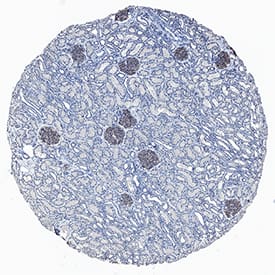Human Nephrin Antibody
R&D Systems, part of Bio-Techne | Catalog # MAB42693
Recombinant Monoclonal Antibody.

Key Product Details
Species Reactivity
Human
Applications
Immunohistochemistry
Label
Unconjugated
Antibody Source
Recombinant Monoclonal Rabbit IgG Clone # 2795E
Product Specifications
Immunogen
Mouse myeloma cell line NS0-derived human Nephrin protein
Gln23-Thr1029
Accession # O60500
Gln23-Thr1029
Accession # O60500
Specificity
Detects human Nephrin in direct ELISAs.
Clonality
Monoclonal
Host
Rabbit
Isotype
IgG
Scientific Data Images for Human Nephrin Antibody
Nephrin in Human Kidney.
Nephrin was detected in immersion fixed paraffin-embedded sections of human kidney using Rabbit Anti-Human Nephrin Monoclonal Antibody (Catalog # MAB42693) at 3 µg/mL for 1 hour at room temperature followed by incubation with the Anti-Rabbit IgG VisUCyte™ HRP Polymer Antibody (VC003). Before incubation with the primary antibody, tissue was subjected to heat-induced epitope retrieval using Antigen Retrieval Reagent-Basic (CTS013). Tissue was stained using DAB (brown) and counterstained with hematoxylin (blue). Specific staining was localized to glomeruli. Staining was performed using our protocol for IHC Staining with VisUCyte HRP Polymer Detection Reagents.Applications for Human Nephrin Antibody
Application
Recommended Usage
Immunohistochemistry
3-25 µg/mL
Sample: Immersion fixed paraffin-embedded sections of human kidney
Sample: Immersion fixed paraffin-embedded sections of human kidney
Formulation, Preparation, and Storage
Purification
Protein A or G purified from cell culture supernatant
Reconstitution
Reconstitute at 0.5 mg/mL in sterile PBS.
Formulation
Lyophilized from a 0.2 μm filtered solution in PBS with Trehalose.
Shipping
The product is shipped at ambient temperature. Upon receipt, store it immediately at the temperature recommended below.
Stability & Storage
Use a manual defrost freezer and avoid repeated freeze-thaw cycles.
- 12 months from date of receipt, -20 to -70 °C as supplied.
- 1 month, 2 to 8 °C under sterile conditions after reconstitution.
- 6 months, -20 to -70 °C under sterile conditions after reconstitution.
Background: Nephrin
References
- Ruotsalainen, V. et al. 1999, Proc. Natl. Acad. Sci. USA 96: 7962.
- Holzman, L.B. et al. 1999, Kidney Int. 56:1481.
- Putaala, H. et al. 2000, J. Am. Soc. Nephrol. 11:991.
- Beltcheva, O. et al. 2003, J. Am. Soc. Nephrol. 14:352.
- Putaala, H. et al. 2001, Hum. Mol. Genet. 10:1.
- Khoshnoodi, J. et al. 2003, Am. J. Pathol. 163:2337.
- Ruotsalainen, V. et al. 2000, Am. J. Pathol. 157:1905.
- Barletta, G.M. et al. 2003, J. Biol. Chem. 278:19266.
- Huber, T.B. et al. 2001, J. Biol. Chem. 276:41543.
- Lehtonen, S. et al. 2004, Am. J. Pathol. 165:923.
- Lehtonen, S. et al. 2005, Proc. Natl. Acad. Sci. 102:9814.
- Verma, R. et al. 2006, J. Clin. Invest. 116:1346.
- Foster, R.R. et al. 2005, Am. J. Physiol. Renal Physiol. 288:F48.
- Coward, R.J. et al. 2007, Diabetes 56:1127.
- Cooper, M.E. et al. 2002, Semin. Nephrol. 22:393.
- Kestila¨, M. et al. 1998, Mol. Cell. 1:575.
Alternate Names
CNF, NPHS1
Gene Symbol
NPHS1
UniProt
Additional Nephrin Products
Product Documents for Human Nephrin Antibody
Product Specific Notices for Human Nephrin Antibody
For research use only
